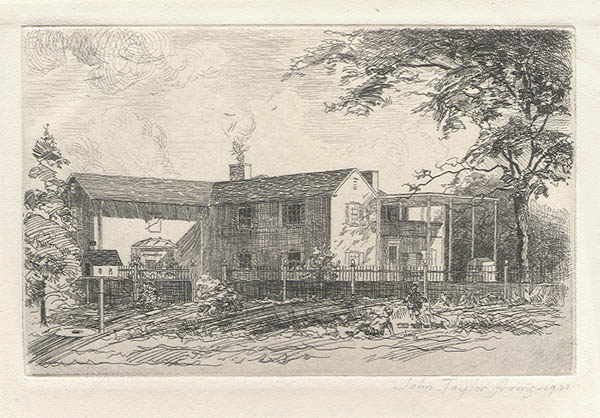| Title: |
Millstone Cottage, Fairfield, Connecticut |
| Artist: |
Arms, John Taylor (Washington, DC, 1887 - Fairfield, Connecticut, 1953) |
| Date: |
1921 |
| Medium: |
Original Etching |
| Note: |
John Taylor Arms: During the 1920's, 30's
and 40's, the etchings and aquatints of John Taylor Arms provided the standard
for other American architectural artists to follow. No artist, however,
could match Arms' superb technical skills and, to this day, his incredibly
precise and detailed etchings raise feelings of astonishment. |
| |
Given the quality of his work it is not surprising that John Taylor Arms
trained first as an architectural draftsman before devoting himself to the
art of etching. During the First World War he served as an officer in the
American navy . He published his first original etchings in 1919, following
the end of the war. During the proceeding decades, Arms spent almost as
much time in England, France and Italy as he did in his native country.
Arms' lifelong passion was for Gothic architecture and thus Europe was the
setting for much of his great art. |
| |
His technical expertise was without equal. Sometimes he employed the fine
points of sewing needles to score the etching ground with precision to
render the finest shades and tones. Such innovations secured a fine international reputation for Arms.
One author writes,
“Arms' images were handsome elaborations of an older
tradition rendered with impressive technical mastery. These constant features
sustained his reputation on both sides of the Atlantic which was buttressed
by the knowledgeable praise of Campbell Dodgson, historian of the art and
Keeper of Prints at the British Museum, and by the joint publishing of his
etchings by Colnaghi & Company in London and by Kennedy & Company in New
York.” *
|
| |
John Taylor Arms was a full member of the Chicago Society of Etchers,
the Print Society of England, the Canadian Painter Etchers, the Associe
de la Societe des Beaux-Arts, Paris, and served as the first President of
the Society of American Etchers. Examples of his original etchings and aquatints
are included in the collections of most major museums, including the Congressional
Library, Washington, the British Museum, London, and the Bilbiotheque Nationale,
Paris. |
| Raisonne: |
William D. Fletcher, John Taylor Arms: A Man for all
Time: The Artist and his Work, Boston, 1982. |
| |
Catalogue: Fletcher #109 Second State of Two as printed in seventy- five signed s. |
| Reference: |
* James Watrous, A Century of American Printmaking: 1880-1980, Madison, University of Wisconsin Press, 1984, pp. 80 & 81. |
| Edition: |
Limited edition of seventy-five signed s. |
| Size: |
3 X 4 5/8 (Sizes in inches are approximate, height preceding width of plate-mark or image.) |
| |
Matted With 100% Archival Materials |
| Condition: |
Printed upon fine, hand-made paper and margins cropped to
about 1/2 inch from the plate-mark on all sides. Signed and dated by the
artist in pencil to the lower right. A finely printed with full
plate-tone and in very good condition throughout. Millstone Cottage,
Fairfield Connecticut, represents a beautiful, original
example of the famous etched art of John Taylor Arms. |
| Price: |
Sold - The price is no longer available. |
| Important Information: |
The artist biographies, research and or information pertaining to all the original works of art posted on our pages has been written and designed by Greg & Connie Peters exclusively for our site, (www.artoftheprint.com). Please visit us regularly to view the latest artworks offered for sale. We will soon be posting an update of our most recent research and include the biographical and historical information pertaining to our next collection of original works of art created by artists throughout the centuries. We hope you found the information you were looking for and that it has been beneficial.
Our Gallery, (Art of the Print / www.artoftheprint.com) guarantees the authenticity of every work of art we sell 100%. Full documentation and certification is provided. We offer a wide selection of international fine art dating from the early Renaissance to the contemporary art period. |







![]()
![]() or
phone Greg & Connie (905) 957-6666
or
phone Greg & Connie (905) 957-6666